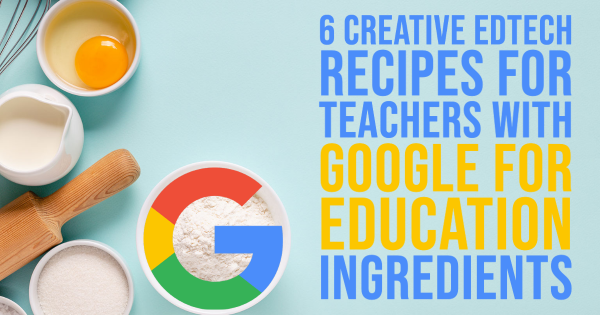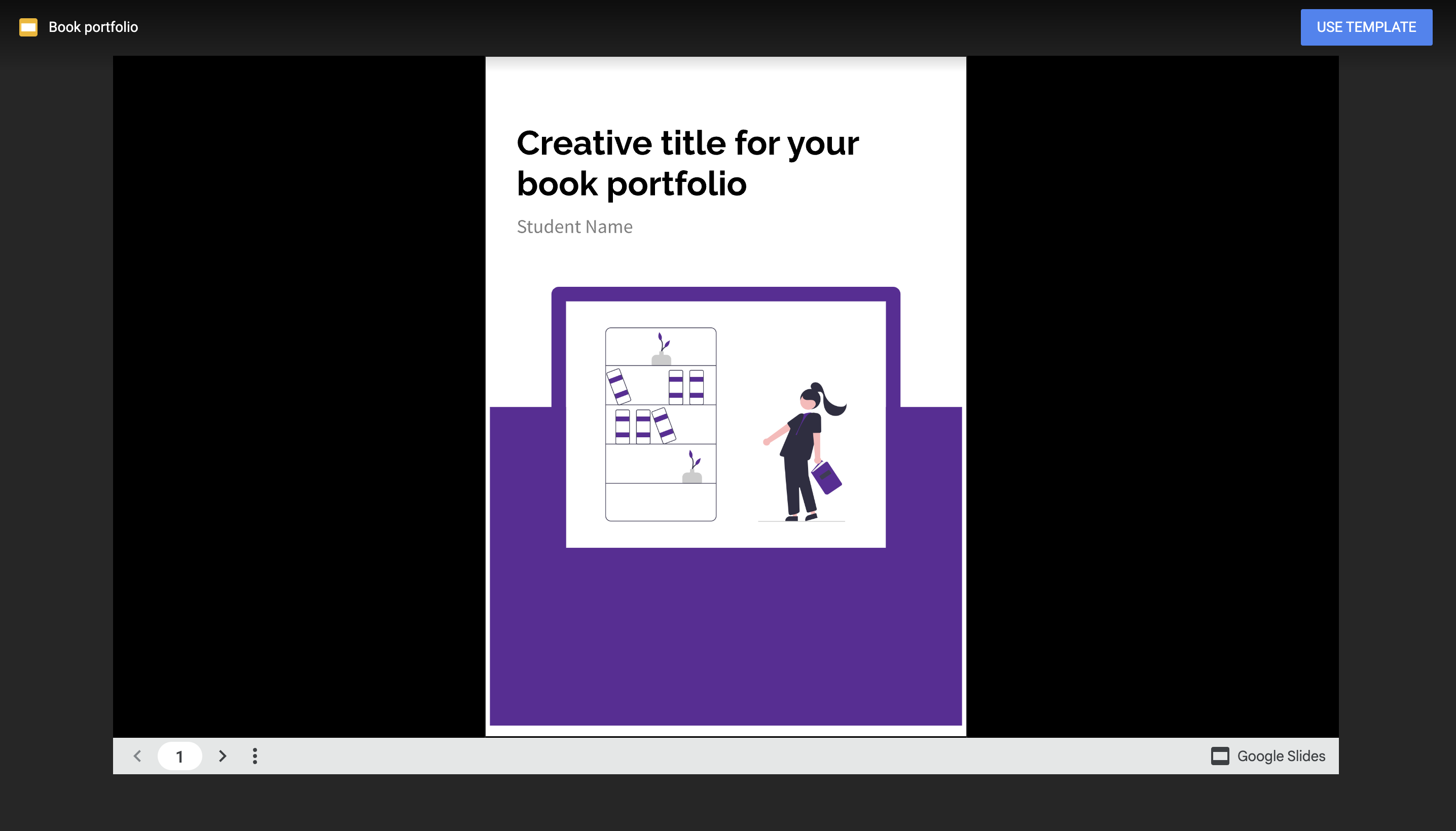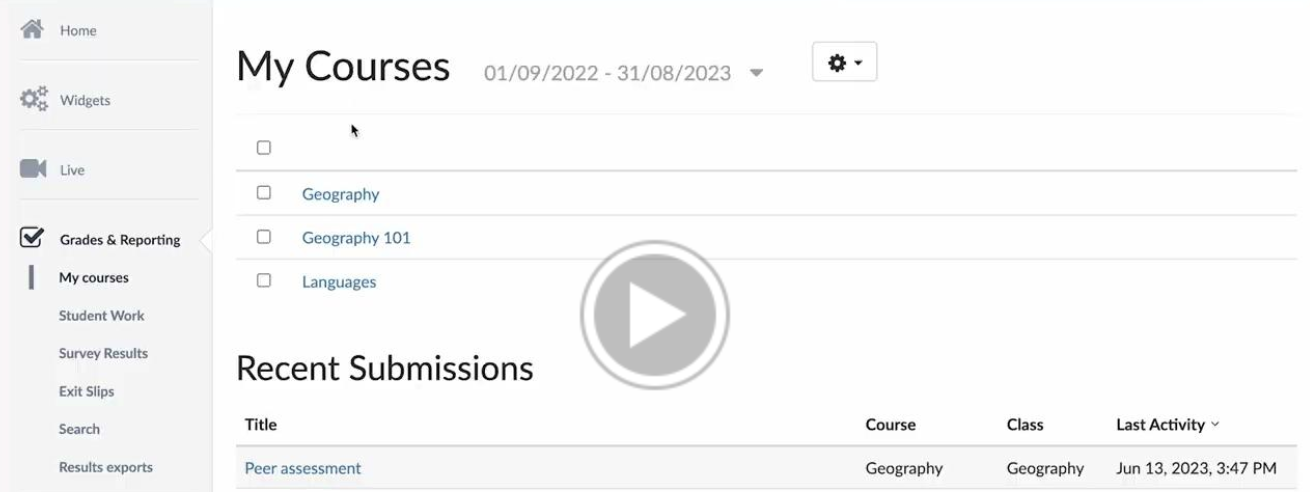6 Creative Edtech Recipes for Teachers with Google for Education ingredients
 Lucie Renard —
Lucie Renard —
Last Sunday, I joined “The Great Google Bake-off” on ISTE, a substantial edtech conference in the United States. A select group of educators and educational content creators put on their aprons and started cooking! There were 6 tasks. The chefs got the ingredients for each task and had to develop a tasty new dish. A creative lesson using Google Workspace for Education tools. The Google Bake-off is an initiative from the Google Educators Community, and thanks to Stephanie Howell and her team, I had the most fantastic time! If you’d like to learn even more, check out the YouTube stream of the complete event!
In this post, I want to show the 6 recipes I created for the Google EdTech kitchen. You’ll get a link to every resource. I hope they can inspire you to think out of the box and use other tools, like BookWidgets, alongside your Google for Education tools. 💪
Before I move on, I have a little assignment for you! Think about how you would tackle the task. What creative recipe would you come up with using the provided ingredients? Let’s go! 👇

Task 1: Creativity
Create a resource for utilizing Google Slides beyond traditional presentations. In this contest, participants will showcase their proficiency in utilizing Google Slides for an interactive activity.
👩🍳 My recipe for success
I used Google Slides to create a creative and fun book portfolio for students with interactive tasks! You can find it here. Students get to read books and report on them in this creative book portfolio, created with Google Slides. They have to replace parts of the text in the book portfolio bundle with the book they’ve read and the results of their interactive book reports and reflections.
I have 4 big tips for you:
- In your Google Slides link, you can replace the “edit” with “template/preview”. This way, your students can take a look at the resource and are forced to copy the template, keeping them away from your original design. The template/preview code is a good alternative to the /copy code, so students really know what they are copying in the first place.
- Change the page setup of your slides. Click “File”> “Page setup” to adjust the dimensions of your slides. In my book report activity, I choose an A4 page setup as it should represent an interactive “worksheet bundle”.
- Use BookWidgets to add creative activities for choosing a book and for the book report. Instead of providing your students a list of books to choose from, you can make the choosing process so much more fun with BookWidgets. For each book, I added a fun BookWidgets activity to pick a book. I also added creative book report activities like creating an interactive timeline of writing a comic book. Make sure to check out the links in the book portfolio!
- For the book reflection part, I added exit tickets on the slides. Students get fields to fill out by typing their answers in the provided fields. Use shapes (Insert > Shapes) and icons to create these exit tickets (=student reflection). I also used “The noun project” to get the best icons!

Task 2: Discussion
Contestants will use Google to design an interactive discussion among students.
👩🍳 My recipe for success
I use interactive exit tickets to follow student activity live in Google Classroom to spark the discussion. When you combine your Google Classroom with a content creation and evaluation platform like BookWidgets, you can do some magic! With BookWidgets, I created two exit tickets about SDGs to spark the discussion. You can find them here to see how they look: Exit Ticket 1 (Start discussion) & Exit Ticket 2 (Follow-up question).
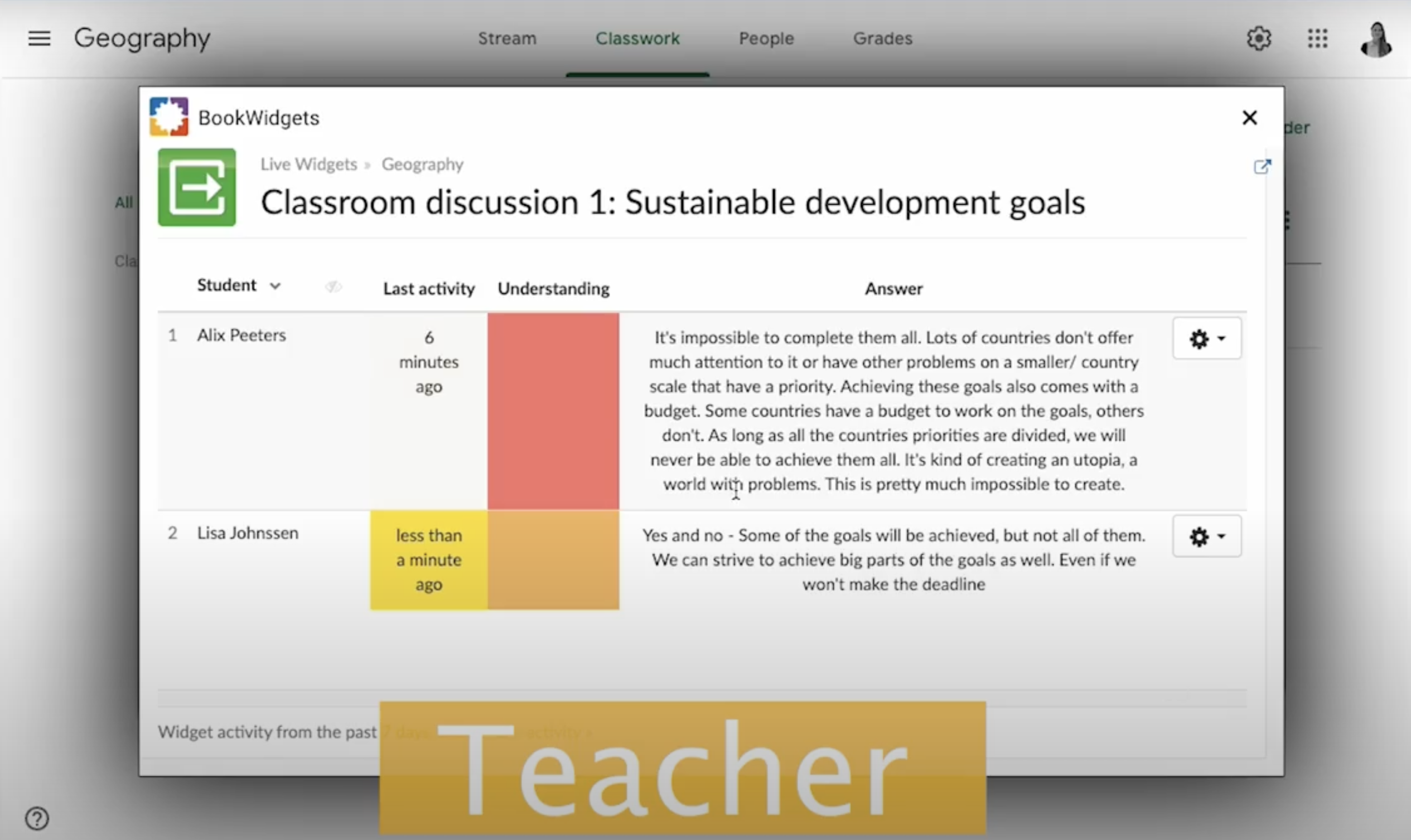
This classroom discussion happens in 3 steps:
Create the exit tickets in BookWidgets and share them with your students through Google Classroom. This is very important as you’ll be able to follow their progress in the questions live in Google Classroom.
When you’ve installed the BookWidgets Google Classroom Chrome extension, you’ll be able to click on the BookWidges icon and open a live monitoring dashboard in your Google Classroom. My idea here is to project the live dashboard on the big screen so my students can watch what others are saying, in real-time. The most important part is the colors you get on the first question. Here I ask if my students agree or do not agree with a statement. They have to indicate an emoji in the exit ticket, and on the live dashboard, the emoji, will get a color (red, orange, or green). You’ll also see the arguments of your students why they agree or not agree with the statement. You can blur your students’ names in the dashboard if the topic is more sensitive.
Spark the classroom discussion by creating groups. You can sort all students who agree and put them on one side in your classroom. Place the students that don’t agree on the other side. They have to use their arguments to engage in the discussion. You are the discussion host and have to make sure the discussion happens and stays in a safe and welcoming environment.

Task 3: Collaboration
Contestants will create, using Google, a peer evaluation form that assesses teamwork and collaboration skills among students.
👩🍳 My recipe for success
I shared a digital worksheet with peer evaluation rubrics to assess collaboration in Google Classroom so I can use the BookWidgets reporting dashboard in Google Classroom to check and align grades given by my students.
Rubrics are a very good way to assess students on a set of clear criteria. It’s an objective evaluation tool and, thus, perfect for students to use as well for peer evaluations. The only issue: most rubric assessments are a tool for teachers. That’s why I use a BookWidgets worksheet activity. It has a rubric question type that’s for both students and teachers. And when you integrate this BookWidgets peer evaluation with Google Classroom, you, the teacher, also get an integrated reporting dashboard so you can follow up on your students’ peer evaluations. Go check out my peer evaluation form for student collaboration below. You can make a duplicate and use it yourself. You can even adjust it, if needed.
As you can see in the example, students have to give up the names of their group members and tick the boxes in the rubric that apply to each student. They also have to elaborate on why they indicated boxes. All your students submit their evaluations to you so you can take a look at the peer evaluations. All this happens inside Google Classroom. If the scores of your students don’t align, you can still overwrite the given grades in the rubric by ticking a box over what the student checked off. The coolest thing about these rubrics is that the scores automatically show when the teacher ticks the boxes. You’ll have scores for each student now, so you can just count them together. You can also use this rubric activity as a formative evaluation, not attaching grades to it.

Task 4: Character Development
Develop a Social-Emotional Learning (SEL) resource utilizing Google Workspace.
👩🍳 My recipe for success
I created a Google Jamboard resource called “Positivity jars”. Use the positivity jars to cheer up students and remind them to find joy in the tiny things. Every day has little things that bring positivity. Share a forced copy Jamboard with your students whenever you feel your classroom is down a bit, or whenever you feel it’s time to spark some positive thoughts. I made two boards so my students can find an example of the teacher and get inspired when they fill their first positivity jars. This activity is not meant to “track” results. Students don’t have to submit it, but you can open up a 10-minute classroom conversation. Students who want to share what’s in their positivity jars are most welcome to do so!
Go check out the activity below 👇 (You’ll have to make a copy before checking)
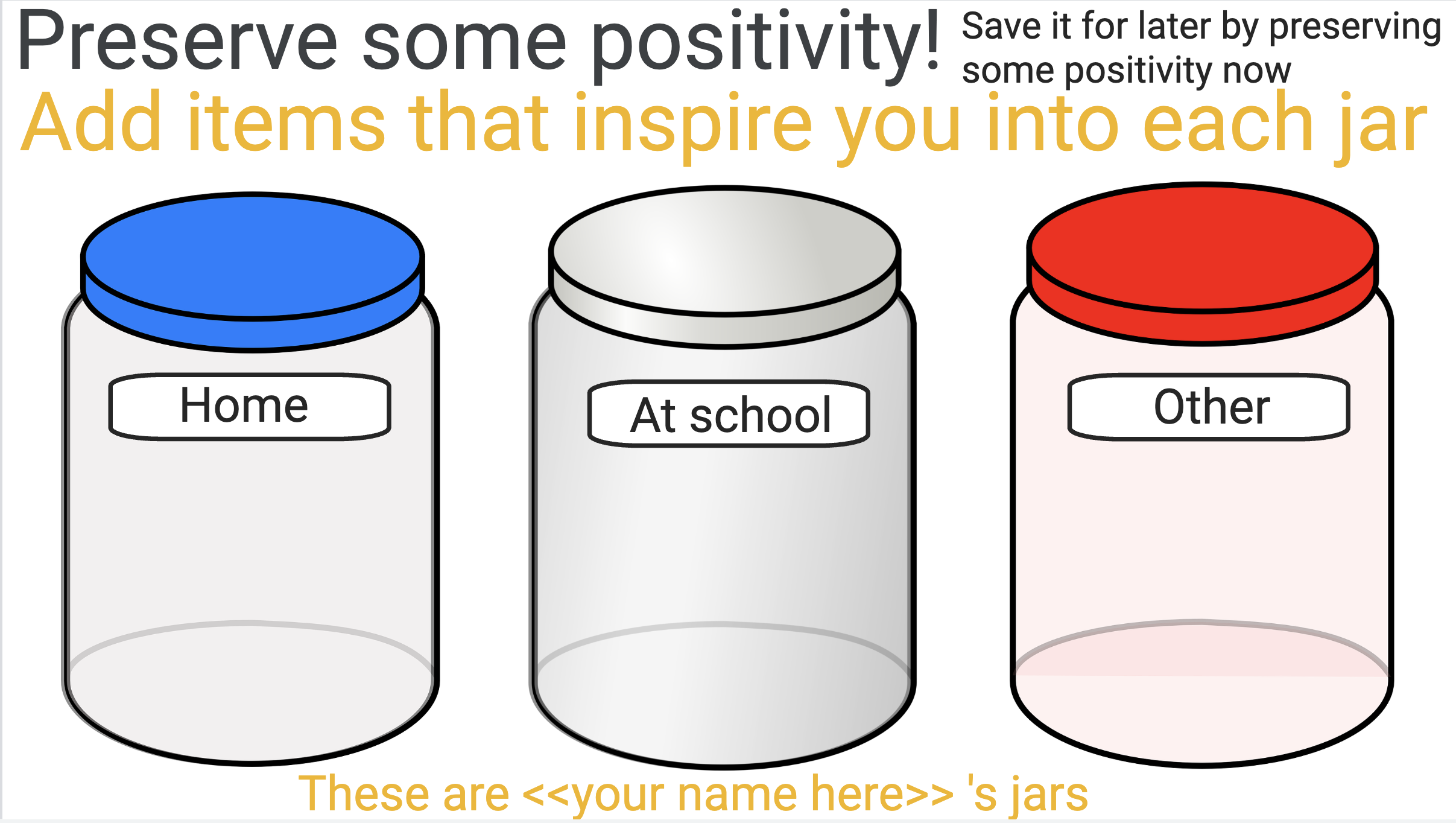

Task 5: Creativity
Contestants will use Google Workspace to create a game-based learning experience for students.
👩🍳 My recipe for success
I created a game of clue using Google Sites! With this game-based learning experience, I want my students to work on different skills. The game will stimulate my students’ reading comprehension, collaboration, problem-solving skills, and raise student and classroom engagement.
Find the ready-to-use game here 👇
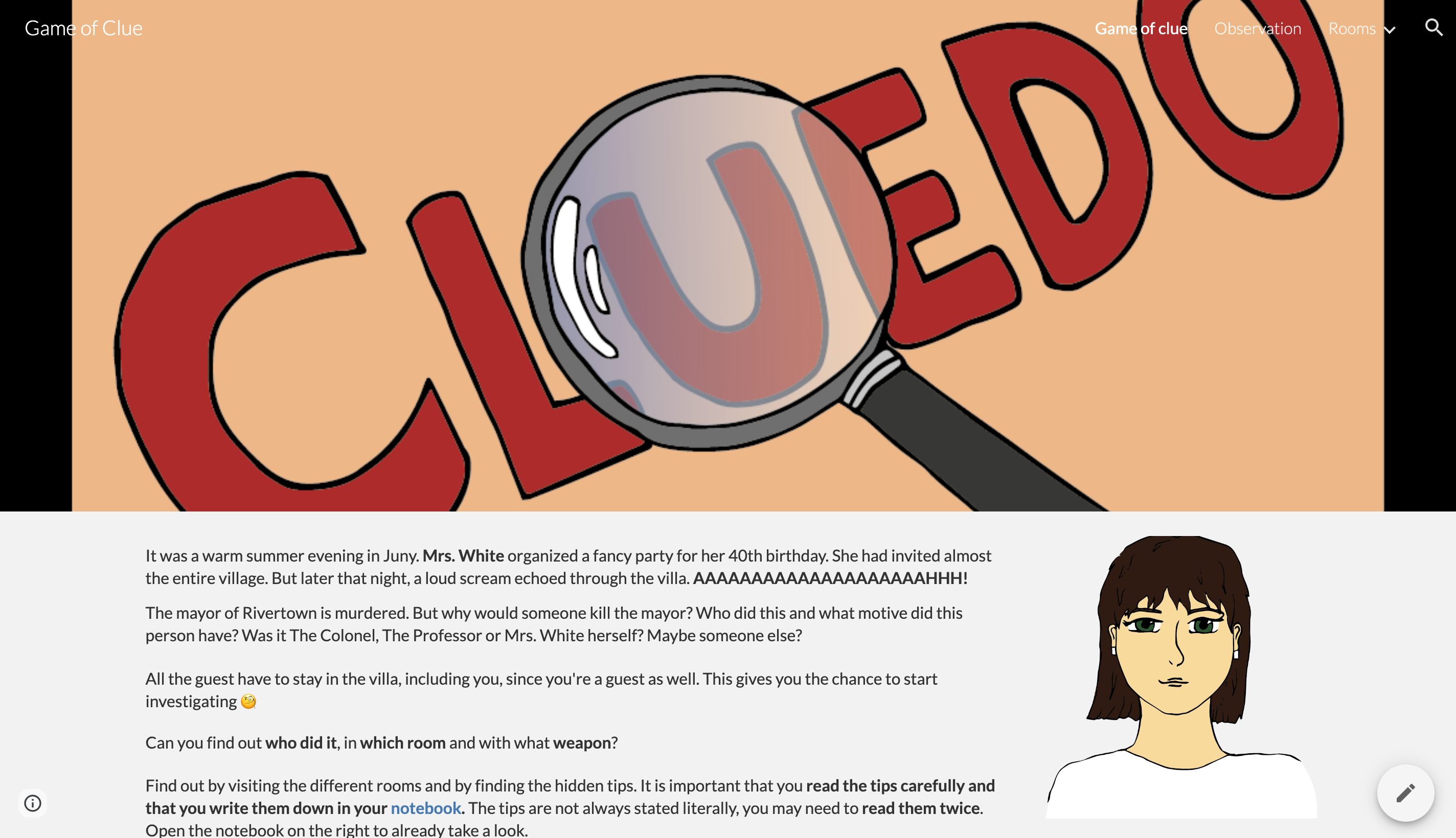
The game is made in Google Sites, and I used BookWidgets to create the notebook evaluation and the hotspot images to discover clues in the different rooms. I even added some BookWidgets games - like jigsaw puzzles or pair-matching activities - to provide clues when students complete them.

Task 6: Insights
Contestants will use Google Sheets to analyze a dataset and draw meaningful conclusions.
👩🍳 My recipe for success
I created insightful pivot tables and charts based on BookWidgets grades downloaded from a Google Classroom course. When you’ve integrated your BookWidgets account in Google Classroom, all grades on BookWidgets tests and exercises are immediately synced. When a certain school period comes to an end, you can draw handy pivot tables and charts from those grades in Google Sheets. Go check out my video below to see how I did this. I can imagen it’s a bit hard to follow if you’re not a Google Sheets expert. Don’t worry about it! I had to learn too. My colleague, Frederic, helped me out and explained how I could get the results I wanted.
Using the pivot tables and charts in Google Sheets, I’m able to use handy filters. I can change the chart in one click to zoom in on particular students, compare grades and find the averages for each test. This way, I can find some “problem” areas and use them to redirect students or redefine my assignments.
Wrap up
That’s it for my recipes! I hope you liked my cooking! Make sure to check out the live stream of the entire event here, so you don’t miss out on all the recipes of my fellow chefs.
And me? I’m Lucie Renard. Give me a follow on Twitter, and now you’ve learned more about BookWidgets, make sure to join the BookWidgets Facebook community or connect with BookWidgets on Twitter!
